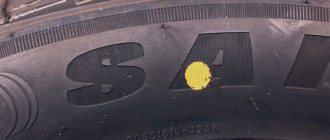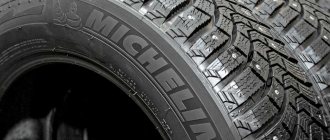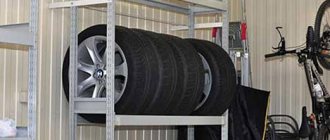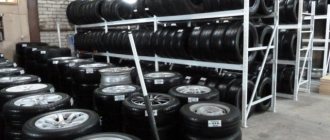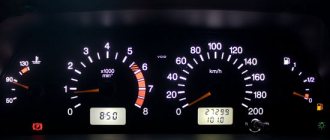Determining the production date of a car tire is an important point that determines how long the product can be used without risk to road users. You can find out the year of manufacture of rubber by special markings on the side parts of the product. This indicator should influence the final choice of the consumer when purchasing tires, and the country of manufacture is also taken into account. 80% of retail outlets, when asked whether the age of a tire matters, answer that it does not. However, this is 100% deception. According to research by manufacturers Hankook, Continental and other global brands, a tire can be stored in proper conditions for up to 5 years from the date of production. Therefore, when asked: is this index important, the correct answer is yes.
There are differences in the service life and storage of different models. For example, Bridgestone-Blizak or Ice Cruiser 7000 tires, when properly stored, retain their properties for up to 5 years, and summer models can be stored for no more than 120 months.
By purchasing a fresh product, the motorist guarantees himself the necessary supply of time during which the rubber will retain optimal elasticity, strength and tenacity. If a tire is 3-4 years old or more, the likelihood of cracking increases critically and traction is lost. Winter options may completely lose their properties and become rough, which can increase the braking distance significantly.
How to find out the production date of tires
To begin with, we note that all manufacturers of tires, be it branded Pirelli or inexpensive Kama, put information about the date of their production on the sidewall, along with numerous other markings.
A distinctive feature of the information that sets it apart from others is the oval stamp, and this fact does not depend on the country of manufacture or any other features.
But the decoding itself is not as banal as we are used to. It does not lead to a specific date, but only talks about the year and week in a row. For example, if the oval stamp shows the numbers 1619, then the tire was produced in the 16th week of 2022, which is April.
The specific number, much less production time, is not indicated by any of the manufacturers. For rubber produced before 2000, the marking code consists of three digits, where the first two are the week, and the third is the last digit of the year.
Can the release date be faked?
The production date of the tire, encrypted in the identification code, is one of the important indicators, along with the tire size, load and speed indices. Old tires are not recommended for purchase. Therefore, sometimes careless sellers try to disguise this parameter. A fake inscription can be identified by careless markings or uneven numbers.
Fortunately, this situation does not happen often, but sometimes it happens that the recording is completely erased from the sidewall. How to determine the production date of a tire in this case? This is where the World Wide Web comes to the rescue. Just write the tire model and look at the years it was produced. As a rule, tire manufacturers update their models, and you will find out when a particular set was produced.
Is labeling required?
We found out where to look at the year of manufacture of rubber, but is it always there or is marking not a legal requirement for manufacturers?
In Russia, the Department of Transport is responsible for the certification of car tires, and it has decided that all wheels sold in our country must be marked.
Otherwise, the product will not be able to appear on the market. The strict rule is followed by all leading suppliers, including our most popular drivers Michelin, Nokian and Yokohama.
As for the European Union, America and other countries, other services are responsible for special information marks, but information about the production period, technical features of the wheel, its size and much more is required there too. Therefore, you can find the treasured numbers in any case.
It is important to note: Externally, the marking of American tires differs from Russian and European ones, so you need to read it according to different rules.
Tire aging
The date of manufacture of a tire can be a determining factor when purchasing shoes for a car. Each rubber has its own shelf life. Even if the tire mileage is extremely low, you cannot drive on one set for the rest of your life.
Over time, tires are exposed to the destructive effects of the environment. The sulfur compounds inside the mixture are destroyed, and the tread itself becomes less elastic. Such tires lose their properties and the rubber simply refuses to provide the proper level of grip on the road.
Independent researchers analyzing serious accidents in several European countries have found a very interesting fact. Most accidents are caused by cars with old tires. Regardless of how famous the manufacturer is, any Bridgestone, Nokian, Yokohama or Dunlop tires have a certain lifespan. The average value is 6-7 seasons, although the French manufacturer Michelin gives a more optimistic forecast at 8-9 years at constant standard loads.
Standard bridgestone or Goodyear summer tires can last 7-8 years under normal driving conditions. A regular tire contains special softeners, which, with constant exposure, prevent the rubber from hardening and prevent cracks from appearing. However, this is relevant if the tire is used regularly. Therefore, if you bought wheels that were produced 4-5 years ago for constant driving, then it is quite possible to use them for another four seasons. If you have to drive infrequently, it is better to look towards tires with a more recent release date.
If we are talking about high-speed yokohama or dunlop tires, then the date of manufacture has more weight. Rubber that experiences high speed loads loses its properties faster. Therefore, it is advisable to change such tires every 3-4 seasons. This applies to products with speed index H and higher.
To determine the speed index on a tire, you should look at the sidewall. The year of manufacture is written on the inside of the wheels, and on the outer diameter there is a load index along with the speed category. The letters H, V, W or Y indicate high speed loads. These letters correspond to maximum speeds of 210, 240, 270 or 300 km/h, respectively. Such kits should be changed more often.
Winter tires have an additional pictogram in the form of a snowflake or the Latin letter W, which stands for Winter. The winter tire mixture consists of softer varieties. These wheels require more attention. Due to the special composition, the shelf life of the tire is reduced to 4-5 years. These parameters are recommended by leading manufacturers Michelin or Nokian, after which it is recommended to replace the kit.
It should be understood that the year of manufacture of tires is not always an accurate indicator for changing shoes. Much depends on operating conditions. If you drive intensively, you can roll the kit in one season. An excellent indicator of tread wear are Twi marks applied around the entire circumference of the wheel. The deepest is at a tread height of 1.6 mm (for winter tires -2 mm) and is the minimum permissible.
Also, if tires have been stored incorrectly, their shelf life will also decrease. The question of how to properly store tires is also relevant. If the set does not have disks, then the wheels should be stored standing up, turning them over once a month. It is not recommended to hang the set, as constant pressure on the cord can damage its integrity. Tires and rims can be stacked horizontally on top of each other or suspended, but do not stack them vertically in the same position.
Tires manufactured before 2000
We've already touched lightly on the topic of coding differences between tires manufactured before the early 2000s, but let's look at this topic in a little more detail. The encoding in the 20th century was three-digit, so it might look something like this: “248” or “*248*”. In this case, the first two digits will always indicate the week of release, and the third - the year.
But what specific year are we talking about: 98 or 88? Wheels produced in 1998 are marked with asterisks. Sometimes they are replaced with a triangle or a space. Tires created in 1988 are identified only by numbers, without spaces or special characters.
And this applies to the entire time period before 1990. It is unlikely that you will be able to find rubber made in the 70s, but in terms of markings it is no different from a product made in the 80s.
This shortcoming is due to the fact that previously the wheels were used for much less than ten years; there was simply no need for additional designation.
How to determine the direction of rotation of a Dunlop tire?
Tire installation
Beginners often when buying tires
from cannot
determine directions
. Everything is extremely simple, the company indicates on the side the outer side with the word “Outside”, and the inner side with the word “Inside”.
Interesting materials:
How to rinse your nose with sinusitis? How to rinse your nose with saline solution? How to number pages in Word 2007? How to write a sales funnel? How to let pedestrians pass at a crossing? How does Hoble progress? How to cancel at the checkout? How to carry out land surveying? How is administrative detention carried out? How is a vehicle inspection carried out?
Do tires have an expiration date?
We figured out how to determine the year of manufacture of a tire, depending on its generation, but is it really that important? Externally, wheels from the 80s are not much different from modern ones, especially if all this time they were in storage and not in use.
Any manufacturer, be it American Goodyear or Japanese Bridgestone, gives a guarantee of only 5 years for its products. This means that during this period the rubber will not change its elasticity, strength, or other technical characteristics. It doesn't matter whether the wheels were actually used or not.
But modern technologies create high-quality tires that, if properly stored, can remain normal for a longer period of time - 10 years. After this period, it is still not worth buying tires, even if they continued to be in the warehouse and were not used.
Why find out the manufacturing date of tires?
So does it make sense to look at the date of manufacture of tires, since the number of kilometers on them is still not displayed? This parameter is worth checking out when purchasing new tires. In this case, it is useful to know when they were made. Due to improper storage, they can deteriorate, and in this case, the newer the product, the better. At the correct temperature conditions, tires can be safely stored for 3-5 years. But before purchasing such products, you need to carefully inspect the tires for cracks, wear and other marks. Ask the seller for a quality certificate to avoid unpleasant situations.
Manufacturer's Warranties and Mileage Standards
We found out where the year of manufacture is indicated on the tires and whether it is worth buying stale tires. It's time to talk in more detail about the manufacturer's warranty regarding wear and tear. After all, many car enthusiasts buy tires that have already been used.
Performance standards are set by the certifying body and depend on the type of vehicle the wheels are installed on. According to them, on cars, trucks and minibuses whose weight does not exceed two tons, the maximum mileage is 45 thousand kilometers.
If a heavy vehicle weighs from two to four tons, its critical mileage is set at 60 thousand kilometers, and for road trains with a large weight - up to 70 thousand. After this, the tires must be disposed of, because their further use is not safe.
Summary
As it becomes clear, there are quite a few ways to find out the age of Michelin car tires. The most important thing is to try to determine the age as approximately as possible, since the exact age is very, very difficult to determine, especially if the car tires have already been used by some driver before.
The most important thing to pay attention to when determining age is determining the tread height of Michelin tires. To do this, it is enough to measure this value as accurately as possible and compare it with the standard value. If the difference between these values is relatively small, then the age of such tires will also be small. As this value increases, the age of car tires will correspondingly increase.
The most important thing for drivers is to try to maintain the quality of the Michelin tires they use for as long as possible. To do this, it is enough to treat rubber products as carefully and carefully as possible.
Why do you need to know the year of manufacture of tires?
Is it so important to know where to look for the year of manufacture on tires, given that the range in modern tire centers is updated every season? In fact, the idea that stores constantly change their assortment is erroneous.
Yes, new models just released on the market will most likely appear in them. But previous generations are simply put away in storage until the next season, rather than being disposed of or returned to the supplier.
What does it mean? To put it as simply as possible, popular models from Cordiant, Continental, Hankook or other manufacturers, ordered by a tire center in large quantities, will simply wait out the season in the store’s warehouse and then be put up for sale again.
No one can say for sure how long this cycle will last. Therefore, the risk of running into a product released 3-4 years ago is high. Yes, you will have a few more years left, but much less than you would like.
What is the service life of tires?
When is it necessary to change tires? This issue definitely needs to be clarified. Any tire is a complex mixture of all sorts of chemical components, which can be affected by a variety of factors: driving principle, road conditions, climate, and so on. The loads on the tires are different, which means the tire wear rate is also different.
It is important to carry out independent inspection of the wheels from time to time and periodically contact specialized centers or even suppliers who will carry out diagnostics and point out any identified faults. It is important to notice changes in the appearance of the tires in time, pay attention to the loss of pressure and be sure to contact a professional if the “behavior” of the wheels on the road leaves much to be desired. Technical diagnostics will help you understand whether your tires are worth repairing or whether it’s time to change them. This applies to both tires for passenger cars and tires for trucks and public transport. And, of course, it is always necessary to have a spare tire. Just in case! By the way, this wheel also needs to be checked with special care. Lying idle for a long time and not always storing it correctly often leads to the spare tire becoming covered with cracks and becoming unusable.
If the tires have been actively used for five years, then you need to plan annual diagnostics.
The older the rubber, the faster it wears out, and all sorts of defects appear that should definitely be identified. Despite the fact that it is impossible to determine the date of replacement of old tires with a new set using a calendar method, as a result of the inspection it will become clear whether the existing tires can still serve or whether it is time to buy new ones. If there is a need to replace tires, it is better to update the entire set along with the spare wheel.
Tips for drivers
How to find out and decipher the year of manufacture of a tire is not the only question that worries car enthusiasts. There are a lot of other problems that can be avoided when buying new tires if you follow the recommendations:
- Take care to properly store tires during the off-season so that you change them less often. Buy special bags, but use them no longer than one season. Get new ones for next time.
- Place wheels in a sheltered location away from sunlight. It literally dries out the rubber, shortening its life.
- Monitor tire pressure, for example using sensors. This will increase safety and reduce wear at the same time.
- Monitor tread wear levels. It should be uniform. If this is not the case, then the car has wheel alignment problems.
- Buy tires from trusted manufacturers. They care about their status in the car enthusiast community and always monitor the quality of their products.
It is important to note: Sometimes Russian tire centers, trying to earn more, buy tires in bulk from European countries that have been in storage for at least three years. There it is no longer possible to put such products up for sale, and our drivers are not yet accustomed to tracking the production date. Be careful when purchasing.
How to make your choice correctly?
It is worth paying attention to the tire manufacturer. Big companies spend a lot of effort doing a lot of research into tire wear and service life. A company like Bridgestone owns a large number of research and development centers around the world.
If we are talking about buying a used product, then you should pay attention to the wear of the protectors and appearance. Check for cracks.
Well, the last point is to check the tire for signs of repair, abrasions and irregularities at the base of the rim. This way you can check how it was used before you and how it was stored in warehouses.
Marking on tires according to season and surface.
- M+S - this marking is used mainly by European manufacturers. M stands for Mud, and the letter S stands for Snow.
- AS (All Seasons, Any Season) - the tire is suitable for use at any time of the year.
- AGT (All Grip Traction) is an all-season tire.
- R+W (Road + Winter) - translated means “road” + “winter”. That is, rubber for use in the cold season.
- Frost is the name given to winter tires.
- AW (Any Weather) - suitable for use in any weather.
- A/T (All Terrain) - tires suitable for use on any terrain.
- M/T (Mud Terrain) - the tire can be used on muddy terrain.
- 3PSF (3-Peak Mountain Snow Flake) - special 3PSF marking on the sidewall of the tire indicates successful testing in winter. Unlike the M+S marking, the 3PMSF mark is only applied if the tire meets the “snow performance index” standards. The coefficient of adhesion of a tire to snow-covered road surfaces is calculated based on three main parameters obtained as a result of road tests. Tests for the reliability of adhesion to the surface are carried out during braking on snow and during acceleration, as well as during acceleration during cornering.
Tire markings in metric system
Example of marking analysis: 205/55 R16 94H XL
205 – tire profile width in millimeters. 55 – tire profile height as a percentage of its width. In our case: 55% of 205 mm = 112.75 mm. Tire profile is a relative value and it is important to take this into account when selecting tires. If you want to use 215/55 R16 tires instead of 205/55 R16, then not only the width of the tire will increase, but also the height. This is only permissible if both of these sizes are indicated in the vehicle's operating instructions. A low profile is considered to be a profile less than 45.
If this ratio is not specified (for example, 185/R14C), then it is equal to 80-82%, and the tire is called full-profile. Reinforced tires with this marking are usually used on minibuses and light trucks, where a large maximum wheel load is important.
R – indicates the radial design of the tire, based on the arrangement of the carcass cords. This is not a radius. Previously, there were tires with a diagonal D , but now they are practically not manufactured.
16 – wheel (disc) diameter in inches. This is the “fitting” diameter of the tire on the rim, it is also the inner size of the tire or the outer size of the rim.
94 – load index, index of the permissible load capacity of the tire in our case is 670 kg. Load index table.
This is the level of maximum load on one wheel. For passenger cars, this is usually done with a reserve and is not decisive when choosing tires. The load index is very important for minibuses and small trucks. To calculate the maximum permissible weight of the machine, you need to multiply the maximum load weight of one wheel by the number of wheels. On the wheel itself you can find the inscription Max Load, which will tell you the permissible load on one tire. Values are given in kilograms (kg) and pounds (lbs), 1 pound = 0.4536 kg.
H is the tire speed index, in our case 210 km/h. The larger it is, the faster you can drive on this tire. With this parameter, the tire manufacturer guarantees normal operation of the rubber during constant movement at the specified speed for several hours.
XL is a reinforced tire, the load index of which is 3 units higher than that of conventional tires of the same size.
Tire load index table
| Load Index | Permissible load, kg | Load Index | Permissible load, kg |
| 0 | 45 | 140 | 2500 |
| 1 | 46,2 | 141 | 2575 |
| 2 | 47,5 | 142 | 2650 |
| 3 | 48,7 | 143 | 2725 |
| 4 | 50 | 144 | 2800 |
| 5 | 51,5 | 145 | 2900 |
| 6 | 53 | 146 | 3000 |
| 7 | 54,5 | 147 | 3075 |
| 8 | 56 | 148 | 3150 |
| 9 | 58 | 149 | 3250 |
| 10 | 60 | 150 | 3350 |
| 11 | 61,5 | 151 | 3450 |
| 12 | 63 | 152 | 3550 |
| 13 | 65 | 153 | 3650 |
| 14 | 67 | 154 | 3750 |
| 15 | 69 | 155 | 3875 |
| 16 | 71 | 156 | 4000 |
| 17 | 73 | 157 | 4125 |
| 18 | 75 | 158 | 4250 |
| 19 | 77,5 | 159 | 4375 |
| 20 | 80 | 160 | 4500 |
| 21 | 82,5 | 161 | 4625 |
| 22 | 85 | 162 | 4750 |
| 23 | 87,5 | 163 | 4875 |
| 24 | 90 | 164 | 5000 |
| 25 | 92,5 | 165 | 5150 |
| 26 | 95 | 166 | 5300 |
| 27 | 97 | 167 | 5450 |
| 28 | 100 | 168 | 5600 |
| 29 | 103 | 169 | 5800 |
| 30 | 106 | 170 | 6000 |
| 31 | 109 | 171 | 6150 |
| 32 | 112 | 172 | 6300 |
| 33 | 115 | 173 | 6500 |
| 34 | 118 | 174 | 6700 |
| 35 | 121 | 175 | 6900 |
| 36 | 125 | 176 | 7100 |
| 37 | 128 | 177 | 7300 |
| 38 | 132 | 178 | 7500 |
| 39 | 136 | 179 | 7750 |
| 40 | 140 | 180 | 8000 |
| 41 | 145 | 181 | 8250 |
| 42 | 150 | 182 | 8500 |
| 43 | 155 | 183 | 8750 |
| 44 | 160 | 184 | 9000 |
| 45 | 165 | 185 | 9250 |
| 46 | 170 | 186 | 9500 |
| 47 | 175 | 187 | 9750 |
| 48 | 180 | 188 | 10 000 |
| 49 | 185 | 189 | 10 300 |
| 50 | 190 | 190 | 10 600 |
| 51 | 195 | 191 | 10 900 |
| 52 | 200 | 192 | 11 200 |
| 53 | 206 | 193 | 11 500 |
| 54 | 212 | 194 | 11 800 |
| 55 | 218 | 195 | 12 150 |
| 56 | 224 | 196 | 12 500 |
| 57 | 230 | 197 | 12 850 |
| 58 | 236 | 198 | 13 200 |
| 59 | 243 | 199 | 13 600 |
| 60 | 250 | 200 | 14 000 |
| 61 | 257 | 201 | 14 500 |
| 62 | 265 | 202 | 15 000 |
| 63 | 272 | 203 | 15 500 |
| 64 | 280 | 204 | 16 000 |
| 65 | 290 | 205 | 16 500 |
| 66 | 300 | 206 | 17 000 |
| 67 | 307 | 207 | 17 500 |
| 68 | 315 | 208 | 18 000 |
| 69 | 325 | 209 | 18 500 |
| 70 | 335 | 210 | 19 000 |
| 71 | 345 | 211 | 19 500 |
| 72 | 355 | 212 | 20 000 |
| 73 | 365 | 213 | 20 600 |
| 74 | 375 | 214 | 21 200 |
| 75 | 387 | 215 | 21 800 |
| 76 | 400 | 216 | 22 400 |
| 77 | 412 | 217 | 23 000 |
| 78 | 425 | 218 | 23 600 |
| 79 | 437 | 219 | 24 300 |
| 80 | 450 | 220 | 25 000 |
| 81 | 462 | 221 | 25 750 |
| 82 | 475 | 222 | 26 500 |
| 83 | 487 | 223 | 27 250 |
| 84 | 500 | 224 | 28 000 |
| 85 | 515 | 225 | 29 000 |
| 86 | 530 | 226 | 30 000 |
| 87 | 545 | 227 | 30 750 |
| 88 | 560 | 228 | 31 500 |
| 89 | 580 | 229 | 32 500 |
| 90 | 600 | 230 | 33 500 |
| 91 | 615 | 231 | 34 500 |
| 92 | 630 | 232 | 35 500 |
| 93 | 650 | 233 | 36 500 |
| 94 | 670 | 234 | 37 500 |
| 95 | 690 | 235 | 38 750 |
| 96 | 710 | 236 | 40 000 |
| 97 | 730 | 237 | 41 250 |
| 98 | 750 | 238 | 42 500 |
| 99 | 775 | 239 | 43 750 |
| 100 | 800 | 240 | 45 000 |
| 101 | 825 | 241 | 46 250 |
| 102 | 850 | 242 | 47 500 |
| 103 | 875 | 243 | 48 750 |
| 104 | 900 | 244 | 50 000 |
| 105 | 925 | 245 | 51 500 |
| 106 | 950 | 246 | 53 000 |
| 107 | 975 | 247 | 54 500 |
| 108 | 1000 | 248 | 56 000 |
| 109 | 1030 | 249 | 58 000 |
| 110 | 1060 | 250 | 60 000 |
| 111 | 1090 | 251 | 61 500 |
| 112 | 1120 | 252 | 63 000 |
| 113 | 1150 | 253 | 65 000 |
| 114 | 1180 | 254 | 67 000 |
| 115 | 1215 | 255 | 69 000 |
| 116 | 1250 | 256 | 71 000 |
| 117 | 1285 | 257 | 73 000 |
| 118 | 1320 | 258 | 75 000 |
| 119 | 1360 | 259 | 77 500 |
| 120 | 1400 | 260 | 80 000 |
| 121 | 1450 | 261 | 82 500 |
| 122 | 1500 | 262 | 85 000 |
| 123 | 1550 | 263 | 87 500 |
| 124 | 1600 | 264 | 90 000 |
| 125 | 1650 | 265 | 92 500 |
| 126 | 1700 | 266 | 95 000 |
| 127 | 1750 | 267 | 97 500 |
| 128 | 1800 | 268 | 100 000 |
| 129 | 1850 | 269 | 103 000 |
| 130 | 1900 | 270 | 106 000 |
| 131 | 1950 | 271 | 109 000 |
| 132 | 2000 | 272 | 112 000 |
| 133 | 2060 | 273 | 115 000 |
| 134 | 2120 | 274 | 118 000 |
| 135 | 2180 | 275 | 121 000 |
| 136 | 2240 | 276 | 125 000 |
| 137 | 2300 | 277 | 128 500 |
| 138 | 2360 | 278 | 132 000 |
| 139 | 2430 | 279 | 136 000 |
